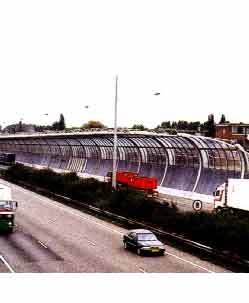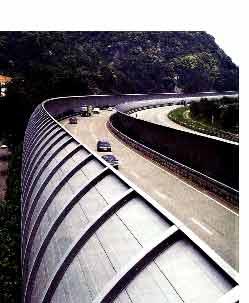|
Laboratory Tests to Determine the Acoustic Performance of Road Barriers |
Complied with:
- ISO 140-3: 1995 (BS 2750 Part 3: 1995) and BS EN 1793-1:1998
- BS EN 1793-2:1998 and BS EN 1793-3:1998
- ISO 10847:1997
- ISO 354
The growth in use of road
traffic noise reducing devices, such as noise barriers across Europe,
the USA, Australia and the Far East (like Hong Kong, Taiwan and Mainland
China) reflects the growing concern of the general public about noise
pollution caused by major infrastructure project, in particular roads
and railways. The growing demand for a quieter environmental has caused
the noise barrier market to grow considerably across the Great Chinese
Area in recent years. The acoustic performance of the noise barriers is
one of the major concerns by the engineers for design of the noise barriers.
To determine the acoustic performance of noise barriers, the European
Committee for Standardization (CEN) has published a standard EN 1793,
which defines test procedures for measuring the acoustic performance and
has been adopted as a British Standard. Part 1 of the standard gives a
laboratory test method for measuring the sound absorption of a barrier,
and Part 2 gives a laboratory test method for measuring the airborne sound
insulation or transmission loss of a barrier. Both tests allow a single-number
rating to be derived for the barrier and to calculate these it is necessary
to use the standardized traffic noise frequency spectrum, which is given
in Part 3 of the standard
1. Laboratory Test on Sound Absorption Performance
Sound absorption coefficients of noise barrier is the fraction of the randomly incident sound power that is absorbed by the noise barriers. Part 1 of Standard BS EN 1793 specifies the laboratory method for measuring the sound absorption of flat noise barrier or flat cladding for retaining walls or tunnels. It covers the assessment of the intrinsic sound absorption performance of roadside noise reducing devices. The test arrangement shall be as described in ISO 354 "Acoustics - measurement of sound absorption in a reverberation room" with some modifications. And a single-number rating DLn can be derived to indicate the performance of the noise barrier. The individual sound absorption coefficients shall be weighted according to the normalized traffic noise spectrum defined in Part 3 of BS EN 1793.
2. Laboratory Test on Sound Insulation Performance
Sound insulation of noise barrier is the capacity of the barrier to prevent sound transmitting through the barrier. Part 2 of Standard BS EN 1793 specifies the laboratory method for measuring the airborne sound insulation performance of roadside noise barrier. It covers the assessment of the intrinsic insulation performance of roadside noise reducing devices.The test arrangement shall be as described in BS EN ISO 140-3 "Acoustics - measurement of sound insulation in buildings and of building elements - Part 3: Laboratory measurements of airborne sound insulation of building elements" with some modifications. And a single-number rating DLa can be derived to indicate the insulation performance of the noise barrier. The individual sound reduction indices shall be weighted according to the normalized traffic noise spectrum defined in Part 3 of BS EN 1793
3. In-situ Determination of Insertion Loss of Noise Barriers
Laboratory testing does allow measurements to be made under controlled conditions, but there are certain drawbacks. To reduce the uncertainties introduced by laboratory testing, in-situ test procedures for barriers using sound intensity techniques is being developed by the CEN working group. And the International Organization for Standardization (ISO) has published a standard for in-situ determination of insertion loss of noise barriers. Insertion loss of barriers is the difference in sound pressure levels at a specified receiver position before and after the installation of barrier provided that the noise source, terrain profiles, interfering obstructions and reflecting surfaces, if any, ground and meteorological conditions have not changed. The Standard ISO 10847:1997 "Acoustics - In-situ insertion loss determination of all outdoor noise barriers types" specifies two methods. The recommended method is the direct method which can be only used if the barrier has not yet been installed or can be removed for the "before" measurements. The alternative method is the indirect method using measured "before" levels at an equivalent site.
 |
 |
Job Reference
1. Industrial Acoustics Company (HK) Ltd. (February-March
2002)
HOKLAS Accredited Laboratory Sound Reduction Index Measurement for Acoustic
Barrier Panels according to ISO 140-3: 1995 for MTRC Contract 520A Stage
2.